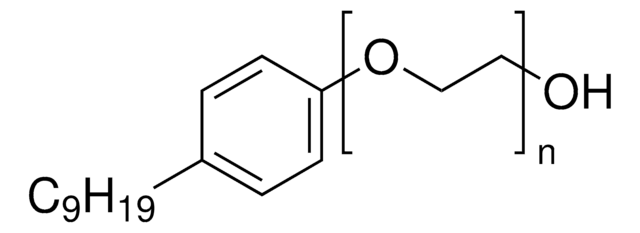SML2166
KML29
≥98% (HPLC)
동의어(들):
1,1,1,3,3,3-Hexafluoropropan-2-yl 4-(dibenzo[d][1,3]dioxol-5-yl(hydroxy)methyl)piperidine-1-carboxylate, 4-[bis(1,3-Benzodioxol-5-yl)hydroxymethyl]-1-piperidinecarboxylic acid 2,2,2-trifluoro-1-(trifluoromethyl)ethyl ester, KML 29, KML-29
로그인조직 및 계약 가격 보기
모든 사진(1)
About This Item
실험식(Hill 표기법):
C24H21F6NO7
CAS Number:
Molecular Weight:
549.42
MDL number:
UNSPSC 코드:
12352200
NACRES:
NA.77
추천 제품
분석
≥98% (HPLC)
형태
powder
색상
white to beige
solubility
DMSO: 2 mg/mL, clear
저장 온도
2-8°C
InChI
1S/C24H21F6NO7/c25-23(26,27)20(24(28,29)30)38-21(32)31-7-5-13(6-8-31)22(33,14-1-3-16-18(9-14)36-11-34-16)15-2-4-17-19(10-15)37-12-35-17/h1-4,9-10,13,20,33H,5-8,11-12H2
InChI key
SXHQLPHDBLTFPM-UHFFFAOYSA-N
생화학적/생리학적 작용
KML29, an O-hexafluoroisopropyl (HFIP) carbamate analogue of JZL184. is a potent and orally active monoacylglycerol lipase (monoglyceride lipase; MAGL; MGLL; MGL) inhibitor (IC50 = 5.9/15/43 nM against human/mouse/rat MAGL) that targets MAGL active site with greatly improved selectivity (rat/mouse ABHD6 IC50 = 1.60/4.87; no inhibitory activity against human/rat/mouse fatty acid amide hydrolase (FAAH) up to 50 μM). KML29 in vivo treatment results in a selective upregulation of 2-arachidonoyl glycerol (2-AG), but not N-arachidonoyl-ethanolamine (AEA) in mice (brain Emax ∼20 mg/kg p.o. or i.p.; peripheral Emax ∼1 mg/kg p.o.) and rats (brain Emax ∼40 mg/kg i.p.). KML29 reduces inflammatory and neuropathic nociceptive behaviour in animal studies without cannabimimetic side effects seen with dual FAAH & MAGL inhibition, chronic administration, however, leads to CB1 receptor desensitization as observed with other MAGL inhibitors.
Storage Class Code
11 - Combustible Solids
WGK
WGK 3
Flash Point (°F)
Not applicable
Flash Point (°C)
Not applicable
시험 성적서(COA)
제품의 로트/배치 번호를 입력하여 시험 성적서(COA)을 검색하십시오. 로트 및 배치 번호는 제품 라벨에 있는 ‘로트’ 또는 ‘배치’라는 용어 뒤에서 찾을 수 있습니다.
Sally Miller et al.
Investigative ophthalmology & visual science, 57(7), 3287-3296 (2016-06-23)
Cannabinoids, such as Δ9-THC, act through an endogenous signaling system in the vertebrate eye that reduces IOP via CB1 receptors. Endogenous cannabinoid (eCB) ligand, 2-arachidonoyl glycerol (2-AG), likewise activates CB1 and is metabolized by monoacylglycerol lipase (MAGL). We investigated ocular
Noemi Pasquarelli et al.
Neurochemistry international, 110, 14-24 (2017-08-23)
The modulation of the brain endocannabinoid system has been identified as an option to treat neurodegenerative diseases including Parkinson's disease (PD). Especially the elevation of endocannabinoid levels by inhibition of hydrolytic degradation represents a valuable approach. To evaluate whether monoacylglycerol
Noemi Pasquarelli et al.
Neuropharmacology, 124, 157-169 (2017-04-05)
Amyotrophic lateral sclerosis (ALS) is a fatal neurodegenerative disease of the motor neuron system with limited therapeutic options. While an increasing number of ALS patients can be linked to a small number of autosomal-dominantly inherited cases, most cases are termed
Maria Morena et al.
Neuropharmacology, 111, 59-69 (2016-08-25)
Systemic activation of cannabinoid receptors often induces biphasic effects on emotional memory and anxiety depending on the levels of emotional arousal associated to the experimental context. The basolateral nucleus of the amygdala (BLA) represents a crucial structure for the ability
Jae Won Chang et al.
Chemistry & biology, 19(5), 579-588 (2012-05-01)
The endocannabinoids 2-arachidonoyl glycerol (2-AG) and N-arachidonoyl ethanolamine (anandamide) are principally degraded by monoacylglycerol lipase (MAGL) and fatty acid amide hydrolase (FAAH), respectively. The recent discovery of O-aryl carbamates such as JZL184 as selective MAGL inhibitors has enabled functional investigation
자사의 과학자팀은 생명 과학, 재료 과학, 화학 합성, 크로마토그래피, 분석 및 기타 많은 영역을 포함한 모든 과학 분야에 경험이 있습니다..
고객지원팀으로 연락바랍니다.